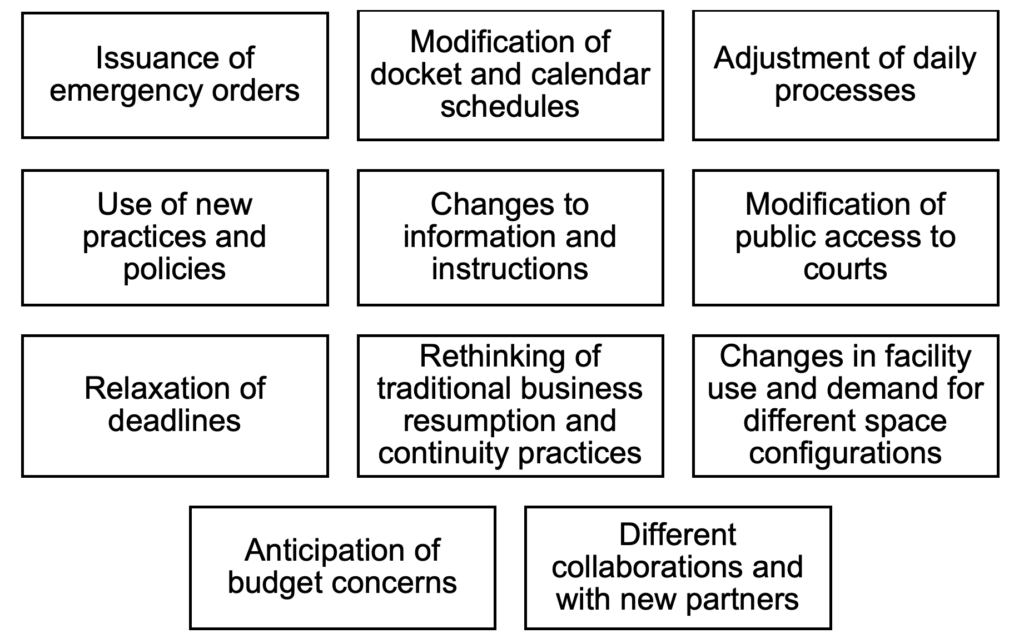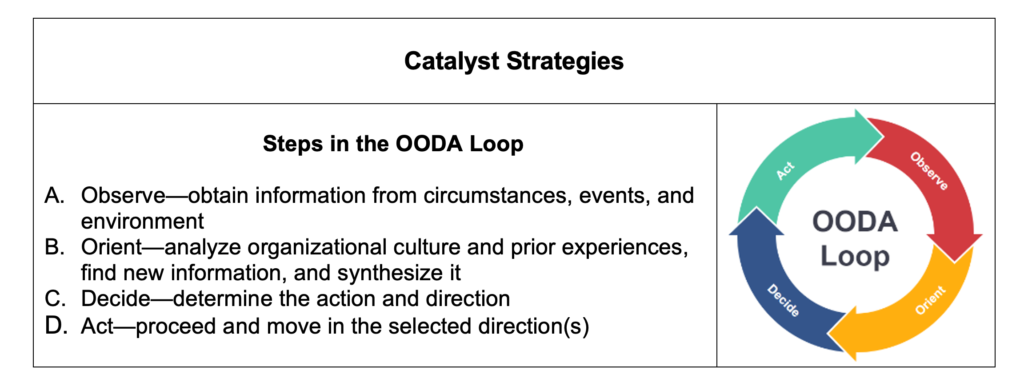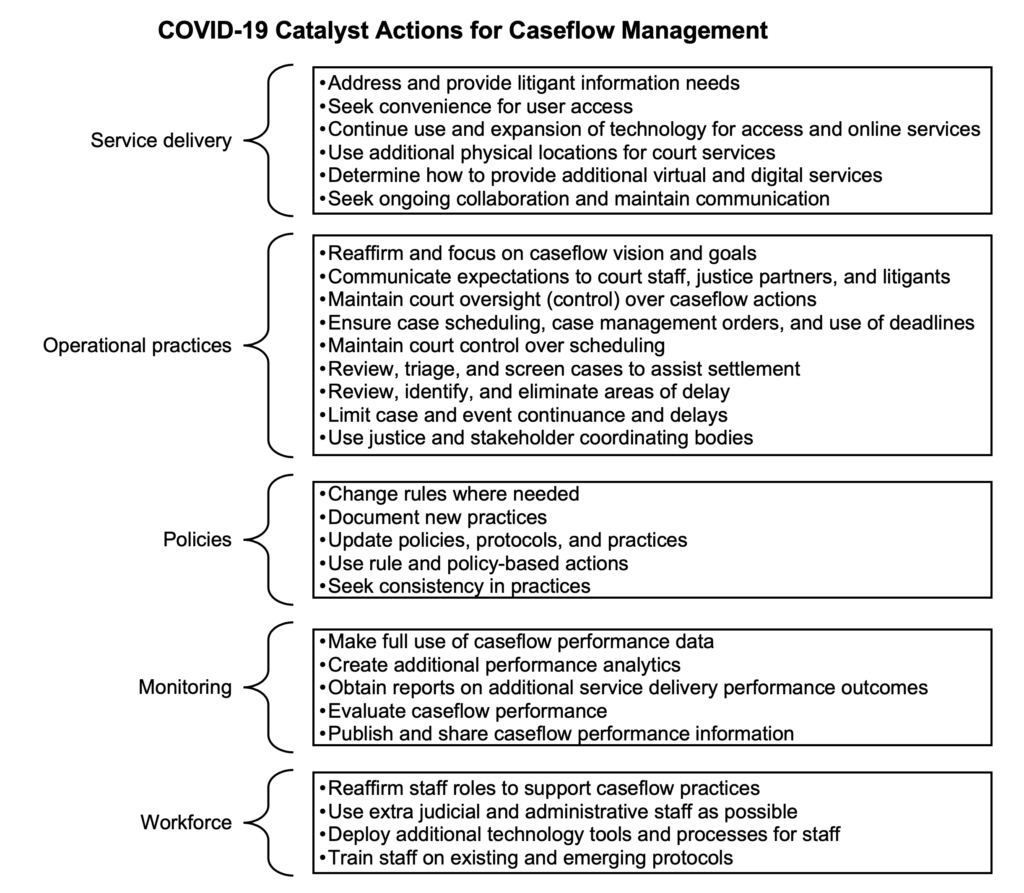COVID-19 and Court Reponses
The novel coronavirus created many changes in court operations. A variety of sources have observed operational responses taken due to the COVID-19 pandemic. A sampling of the changes is noted below.
The Hague Institute for Innovation Law reported COVID-19-related interventions:1
- Closing court buildings
- Using videoconferencing and phone interactions
- Implementing emergency laws
- Using electronic filing
The Justice Management Institute (JMI) has indicated modifications in:2
- Issuing administrative orders curtailing nonessential court events
- Applying cite-and-release practices for traffic and misdemeanor cases
- Reducing in-custody-booking numbers
- Engaging telephonic probation monitoring (in lieu of in person)
- Using videoconferencing for court events
The National Center for State Courts listed the common efforts in response to COVID-19:3
- Limiting or ending jury trials
- Restricting entrances to courthouses
- Generally suspending in-person court proceedings
- Allowing extensions for deadlines and payment of fines
- Encouraging or requiring teleconferences or videoconferences in lieu of hearings
The National Judicial College noted that COVID-19 has prompted actions to correct some ills that have plagued courts.4 Notable corrective actions are:
- Expanding use of technology
- Evaluating existing rules
- Providing “instant access” without requiring in-person attendance
Courts quickly pivoted for different caseflow priorities, allowing remote access and work, and deploying technology rapidly. These changes have the potential to impact caseflow management. Impacts may affect access, practices, timelines, and technology for staff and court users.
COVID-19 Related Changes

Caseflow Management Best Practices
Caseflow management techniques have been documented in many publications and range from leadership and vision to the use of technology and performance measurement.
Caseflow Management Best Practices
- Leadership, goals, and clear vision
- Time standards and performance or processing goals
- Calendaring, case assignment, and date certainty of events
- Case inventory evaluation and backlog monitoring
- Early, regular, and continuous intervention and oversight of cases
- Dispute resolution and settlement practices for case conclusion
- Collaboration and outreach to partners
- Communication, education/training, and information sharing (internally, externally, and with system stakeholders)
- Utilization of technology
- Performance measurement, management, and information dissemination
COVID-19 as a Caseflow Management Catalyst Instead of a Caseflow Catastrophe
Caseflow operations during the coronavirus pandemic are targets ripe for evaluation. The evaluation should include review and evaluation of services, information, processes, and the use of court staff. This evaluation should use a specific process.
The military and law enforcement have used a process called “The OODA Loop” (pronounced “oo” as in poodle and “duh” or “dah”). In this process, four discreet steps are used to orient someone and to determine responses to a situation, surprise, or challenge. The steps are Observe, Orient, Decide, and Act.5 Admittedly, court challenges do not approach the severity of what the military might encounter. However, the concepts may be part of a useful court strategy.

Using the OODA Loop concept, here are some suggested actions to leverage the coronavirus as a catalyst for improved caseflow management.6
A. Observe
- Review and discuss changes implemented during the coronavirus
- Inventory new policies and protocols implemented
- Conduct an inventory of the caseload and possible backlog of cases
- Obtain comprehensive data and statistics about the case inventory
- Identify areas where the caseload composition or complexity may have changed
- Assess the number of calendars and events required to overcome backlog
- Determine staffing resources needed for calendar coverage
B. Orient
- Review caseflow best practices and assess which should be targets for attention
- Assess policies, procedures, protocols and forms for use, implementation, revision, or simplification
- Identify dispute resolution practices to use
- Assess new ideas about facilities use and different configurations
- Evaluate technologies used during the pandemic and determine which to continue, expand, or eliminate
- Evaluate data and statistics collected
C. Decide
- Identify operational areas to amplify attention to caseflow practices
- Determine dispute resolution or diversion processes to use
- Consider attention to focused operational areas7 (pretrial practices, remote/virtual hearings, remote workforce practices, the digital divide for court users/litigants, dispute resolution options including online dispute resolution)
D. Act
When it comes to taking action, court leaders may consider thinking about and conducting caseflow actions within specific domains. As suggested by an article on governing.com,8 actions can be organized into the areas of service delivery, operational practices, policies, monitoring, and workforce.

Conclusions
Attention to caseflow management excellence is ongoing and can be redoubled as a result of COVID-19 influences. Given the breadth and length of COVID-19-related changes, we have the opportunity to renew attention to proven caseflow principles and practices. We can use of the COVID-19 pandemic as a catalyst for enhancements.
As former Arizona Supreme Court Chief Justice Scott Bales noted, we should learn from experience, listen to those we serve, and “use COVID-19 as a reason for new ways of doing things.”9
- See “Delivering Justice in the COVID-19 Crisis,” Hiil User Friendly Justice; and I. Banks, “Measuring Justice Needs and Delivery in a Pandemic,” blog, Institute for the Advancement of the American Legal System, December 15, 2020.
- See search results for “COVID,” Justice Management Institute.
- See “Coronavirus and the Courts,” NCSC Newsroom.
- See J. M. Redwine, “COVID Has Helped Cure Some of the Court’s Ills,” Reflections from the Bench, National Judicial College, September 24, 2020.
- See “OODA Loop,” Wikipedia.
- Several sources were used to suggest caseflow actions: Court Technology Bulletin blog content by Jim McMillan; National Association for Presiding Judges and Court Executive Officers (NAPCO), “Webinar: How Will You Address COVID-caused Criminal Case Backlogs?,” January 21, 2021; the NCSC Civil Justice Initiative; the NCSC Family Justice Initiative; and the NCSC Effective Criminal Case Management Project.
- Possible areas for operational attention include pretrial practices, remote and virtual hearings, remote workforce practices, overcoming of the digital divide for litigants, online dispute resolution, virtual jury processes, service of self-represented litigants, language access via technology, management of high-volume dockets, diversion processes for eviction cases, and case management for civil and family cases. These are noted in the NCSC Implementation Lab Initiative project, funded by the State Justice Institute.
- See W. D. Eggers, “5 Domains of Government that Are Ripe for Transformation,” Governing, January 19, 2021.
- See Scott Bales, former chief justice, Arizona Supreme Court, and former executive director, Institute for the Advancement of the American Legal System, “Civil Justice After COVID-19,” blog, June 1, 2020.



